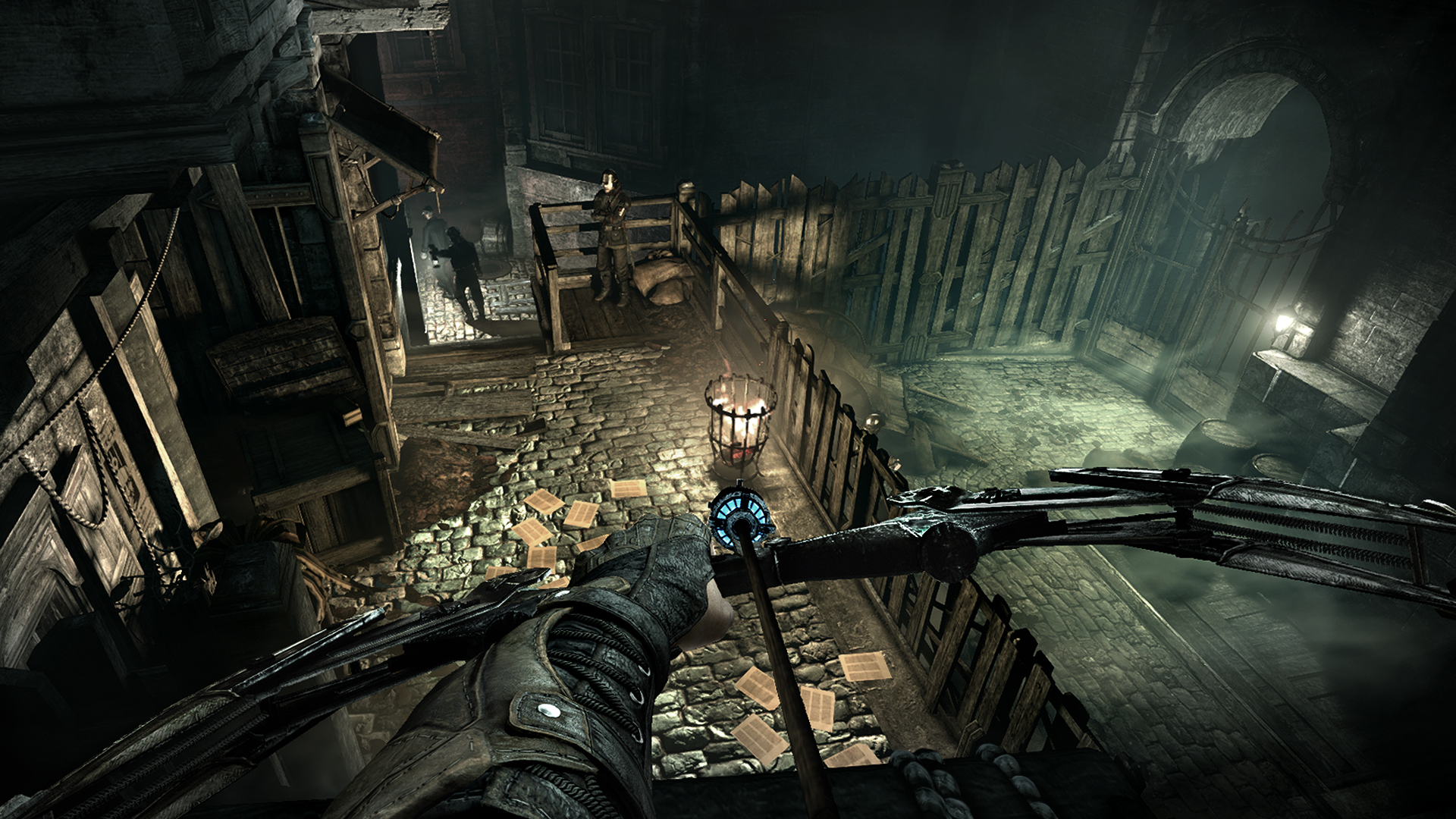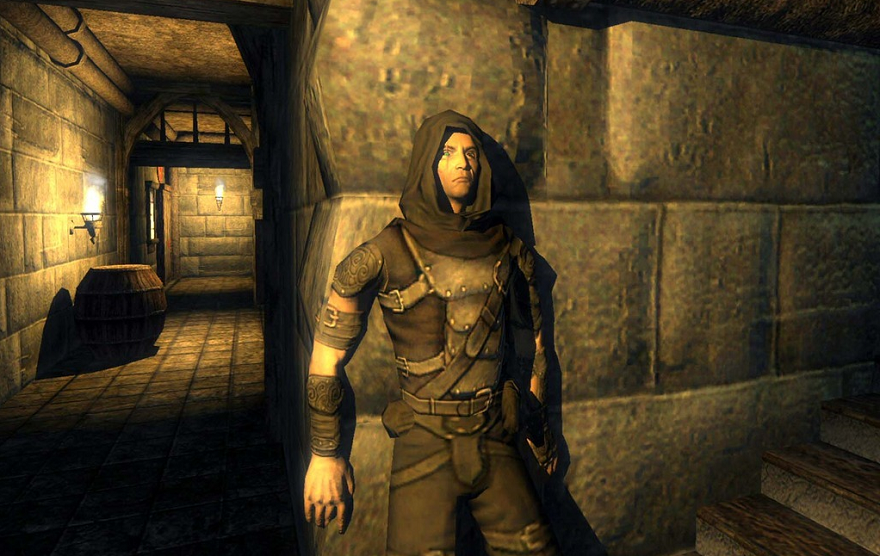If you’ve ever stepped into the dark, wood-panelled interior of a real Tudor room and felt the hairs on the back of your neck prickle, you might understand the strange joy of the Thief games. From the baleful stare of its threadbare tapestries to the oppressive silence, the ancient room says: you are not welcome here. It is charged with hostillity, somehow alert to your presence. To step inside is to take on the role of interloper, intruder.
Tudor buildings were constructed between 1485 and the early 1600s, and today are often charged with a formidable sense of history. It was this period that developed the blueprint for houses as we know them now, moving away from the defensive fortifications of medieval dwellings.
It’s a small step from the Tudor interior to the nocturnal skullduggery of the Thief series. Here, filling the boots and jerkin of master pilferer Garrett, the antagonism of the Tudor room becomes a fact of life for the player, mercilessly expressed at every juncture you sneak through.

As in many stealth games, your strength in Thief is tethered to your environment, earned meter by meter as you sneak, hide, steal and trick your way to success. Needless to say, this fragile power can crumble away at any moment, undone by a misstep, an error of judgement or an unwitting pedestrian bumbling into your hiding place. To abandon your camouflage and confront your enemies head-on is, in all probability, suicide. The weapons at your disposal may be powerful, but only when allied with caution and cunning.
Compared with just about any action-oriented title, in which you’re invited to loudly and proudly flex your muscles or shoot your guns, the power trip in Thief is inverted. Crouching in the shadows, you sometimes feel more like an insect than a hero, surrounded on all sides by threats and obstacles. You have no privilege here; to win you must constantly escape detection. This has long been the modus operandi of stealth games, but none of them have ever done it quite so majestically as Thief.
Some have argued it’s The City—Thief‘s stylised, medieval-steampunk anachronism of a game world—that best expresses the soul of the game. But perhaps we can learn just as much from the uneasy sanctuary offered up by any murky corner in Garrett’s world.
Much like the thrilling unease one feels within the Tudor room, playing Thief delivers a perverse sort of pleasure, tiptoeing between fascination and fear. In psychological terms, how can we explain the appeal of a game in which you’re consistently forced to be an underdog, the odds stacked against you?
Appropriately, academics have so far shed very little light on how stealth games affect us on a psychological level. In fact, there appears to have been no major research focusing on the genre. However, we can pierce the shadows just a little by considering a few psychological ideas alongside Thief.

In 2013, research published by the American Psychological Association identified an unexpected phenomenon dubbed “cheater’s high.” In a study of over 1,000 adults, participants were given the option to cheat in a series of competitions involving word puzzles. Many took the bait, but what was intriguing was the outcome. Rather than feeling guilty as expected, cheaters in the experiment consistently reported a marked upturn in mood.
“A lot of it has to do with the cleverness that people feel,” Nicole Ruedy, a lead author of the study, told TIME. “The idea that they’ve figured out a way to cheat successfully gives them a sense of accomplishment.”
For Dr. Lennart Nacke, an assistant professor and research director from the University of Ontario Institute of Technology who specialises in gaming psychology, the thinking behind cheater’s high is also helpful for understanding why and how we enjoy stealth games like Thief.
“It’s the same feeling you get when bargain shopping,” he told me. “We’re trying to find the best deal, and when we get something better than someone else or feel we’ve bent the rules we get a high out of that.”
Except, in Thief, shoplifting might be a better analogy. As the title suggests, the player indulges in an awful lot of unethical behaviour, and stealing and sneaking your way through each level certainly does supply a buzz.
“The concept of cheater’s high suggests we get a joy out of tricking people, and in Thief you feel like you’re essentially tricking the game, too,” Dr. Nacke elaborates.
Of course, this is a trap. After all, thieving is the lynchpin of your success, and the game is asking you to do so. As Garrett, you are fated to play the world’s greatest cat burglar—an unscrupulous, Machievellian badass. It’s not just your job to be a thief; it’s your destiny. And while the violent world you traverse may—like the Tudor room—make you feel unwelcome at every turn, you are in fact a sanctioned outsider with a licence to steal.
The paradox extends beyond unethical behaviour, right down to how players engage with the game. Dr. Nacke explains that, in a psychological sleight of hand, stealth games will often quietly encourage us to play in a particular style while we simultaneously convince ourselves it’s our own choice to do so.

For example, we may enter an area where it’s possible to brazenly shoot a guard with a fire arrow before defeating two more by sword, taking some damage in the process. While the game allows this, for the committed player such an approach “doesn’t feel right.” If you’ve ever replayed a saved game for this reason (as I certainly have), you’ll understand how persuasive this psychological pressure can be. Your victory was perfectly valid, but somehow feels wrong, out of sync with the essence of the game. Instead, you try again, this time taking a sneakier tact.
“We feel like we’re setting that personal goal ourselves; we have to do it that way or we’re not worthy of the game,” says Dr. Nacke. “If we engage in combat we feel we’ve broken our own rules.” In fact, we’re a puppet on a string. “We act like we’re autonomous, but the game trains us to do this. It’s trickery from the game designer, who asks us to set the goal for ourselves but in actuality does it for us.”
Interestingly, Dr. Nacke believes this bluff means a negotiation is constantly unfolding between player and game—one which is intrinsically exciting for us.
“The fun thing with these cheating games is that the social contract is ambiguous,” he says. “The game allows you to play in both ways – to kill people or stay stealthy. I think it’s that uncertainty that excites us, because we want to hold ourselves to our own ethical standard. The most powerful games tie into this idea of us being autonomous.”
So it may be the “cheater’s high” we get from playing Thief goes far beyond the thrill of stealing shiny trinkets. Actually, a psychological tug-of-war over our free will might be unfolding, just beneath the surface. As if we needed any more proof that Looking Glass Studios was staffed by total geniuses.
The sense of foreboding emanating from the game is likewise rooted in a similar paradox. It brings us back to the Tudor room and its uncanny, watchful presence. In Thief’s own dark corners, the feeling of breathless unease is remarkably similar, expressed in all manner of detail. The dusky Old Master paintings staring reproachfully from mansion walls; the thrilling, metallic chime that resounds whenever you filch something precious; the chessboard of light and dark engulfing a room, simultaneously inviting and admonishing. Without even considering the masterful staging of its missions and their maps, a tightrope act between fear and exhilaration permeates Thief’s design at every level, even its surface.

The fear factor is backed up by narrative counterparts; monsters, ghouls, zombies, apocalyptic religious rites. And once again, it’s linked to the stealth at the heart of the game, crystallising between fear and morbid fascination on a psychological level: a sublime grotesque. “The interesting thing is that the fear factor also acts as a pressure point,” Dr. Nacke explains. “In my opinion, it’s based on two factors; 1) the sense of discovery and wonder, our desire to explore the world and 2) the sense of fear that prevents us from doing so. We weigh the risk at any given point, and it’s this which our excitement hinges on. If you look at the architecture of Thief, at the dark corners for example, they actually draw you in. You want to explore these areas. But on the other hand you always have that fear, that if you step out at the wrong moment all hell will break loose!”
In this way, fear and thrill works as a kind of unforgiving double act, offering the player a tantalising glimpse of what they might be able to achieve—if they only have the courage to face down the inherent risk. Coupled with a game world that’s so explicitly hostile, the effect is one of constriction. Through Garrett, the player is constricted in how she navigates environments, both by the challenge at hand and the stifling fear it creates.
Like the labyrinth of the game world we play in, the psychology behind Thief is laden with twists and trapdoors. In the end, all of them lead back to the ultimate trickster: our own, unconscious self.
